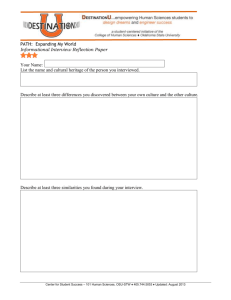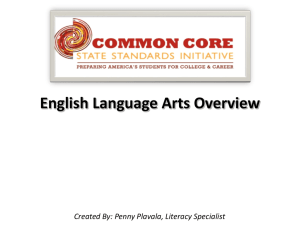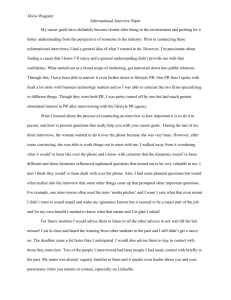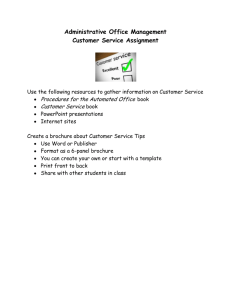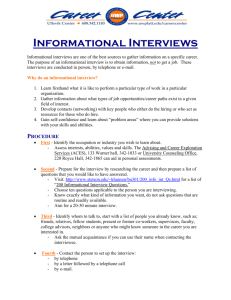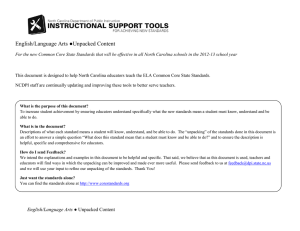Technical Writing Presentation 10-26-11
advertisement
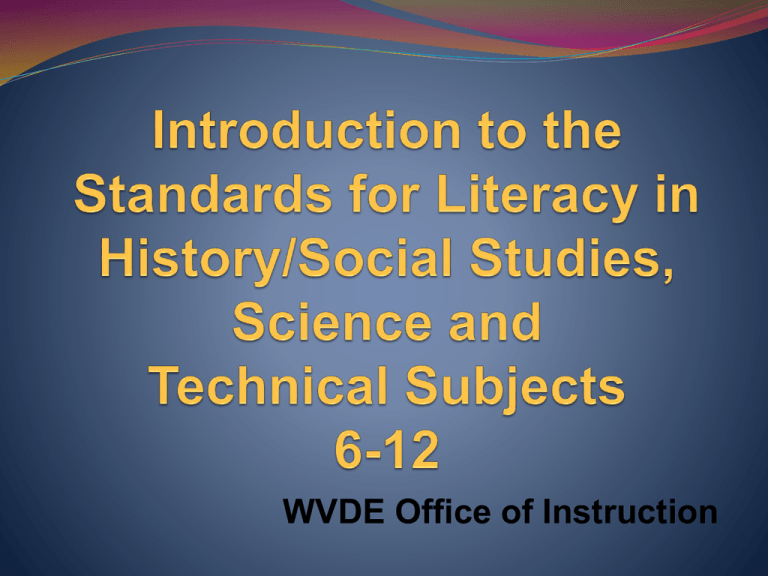
WVDE Office of Instruction Where did we get these standards? Common Core State Standards CCSS adopted by 47 states so far Not a national curriculum More directly aligned with NAEP Fewer and deeper – increased opportunity for mastery Movement of some content to more directly align with developmental levels of students Embedded literacy in all areas Math and English/language arts only at this point Work being done on other content areas Criteria for the Standards Fewer, clearer and higher Aligned with college and work expectations Include rigorous content and application of knowledge through high-order skills Build upon strengths and lessons of current state standards Internationally benchmarked, so that all students are prepared to succeed in our global economy and society Based on evidence and research College & Career Readiness Standards = Anchor Standards ACT Report: Affirming the Goal: Is College and Career Readiness an Internationally Competitive Standard? In the classes you teach: What do your students read? What do your students write? Thoughts to Ponder … “What we read influences what we learn.” “We learn to read by writing and we learn to write by reading.” ELA Standards Advances The standards devote as much attention on what students read, in terms of complexity, quality, and range, as they do on how students read. As students progress through the grades, they must both develop their comprehension skills and apply them to increasingly complex texts. What is Text Complexity? Standard 10 – Range of Reading and Level of Text Complexity It is the difficulty of the text combined with the reader’s ability and the difficulty of the task Text structure Vocabulary Sentence length Illustrations (quality and complexity) Why Text Complexity Matters ACT report – Reading Between the Lines (2006) Research indicates that the demands of college, careers and citizenship on readers has held steady or increased over the last 50 years. Workplace reading, measured in Lexiles, usually exceeds grade 12 complexity. Informational Text Look at the Standards Document on your table or on Teach 21. Read pages 60 and 63 CCR Anchor Standards for Reading and Writing Discuss: What do students have to be able to do in Reading to be college and career ready by the end of the 12th grade? How can I get my students prepared through the content I teach? What do students have to be able to do in Writing to be college and career ready by the end of the 12th grade? How can I get my students prepared through the content I teach? Insights into Anchor Standards? Now Let’s Look at the Objectives Pages 62, 64 - 66 Page 62, 64-66 1. What Reading objectives seem to “jump out” at you? 2. How are Reading and Writing connected? 3. What types of Writing are students expected to do? 4. How can you address the Writing objectives through what you teach? Informational and Argumentative Writing Let’s Look at Exemplars Appendix B: Text Exemplars and Sample Performance Tasks Grades 9-10 - Pages 136 and 138 Grades 11-12 – Pages 180 to 183 What CTE area might read these? What are some vocabulary words students would have to know? Reaction? Let’s Look at Exemplars Appendix C: Samples of Student Writing Pages 98 - 102 or Pages 103 – 107 What type of writing is this (based on Literacy Standards?) What are some vocabulary words students used? What type of research had the student done? Be ready to discuss how the Annotation at the end of each piece validates the Writing Objectives. Reaction? How Do I Use Technical Writing in My Content Area? Career & Technical Education Cluster Technical Writing Health Services Observation Report, Survey, Letter of Inquiry, Interview, Brochure, Action Plan, Progress Report, Persuasive Letter, Patient Charting, Journal, Research, Transcription Human Services Action Plan, Process Explanation, Observation Report, Instructions, Evaluation, Interview, Website, Progress Report, Advertisement, Proposal, Critique, Review, Business Letter, Proposal, Job Application Science/Natural Resources Observation Report, Brochure, Proposal, Training Manual, Newsletter, Progress Report, Budget Plan, Data Report, Research, Website How Do I Use Technical Writing in My Content Area? Career & Technical Education Cluster Technical Writing Engineering/ Technical Observation Report, Proposal, Letter of Inquiry, Interview, Brochure, Action Plan, Progress Report, Training Manual, Instructions, Estimate, Audit Report, Work Order Arts and Humanities Action Plan, Process Explanation, Advertisement, Review, Instructions, Evaluation, Interview, Website, Progress Report, Budget Plan, Proposal, Newspaper or Magazine Article, Publication Business/ Marketing Observation Report, Brochure, Proposal, Training Manual, Newsletter, Progress Report, Business Plan, Marketing Plan, Publication, Contract, Review Role Audience Format Topic You are a chef who is opening your own restaurant. You must get the news out to your potential customers. Design a press release to be placed in the local newspaper. It should contain the name of your restaurant, the opening date, and the type of foods you will serve. Your Try: Role Audience Format Topic Action Plans Business Letters Business Plans Contracts Descriptions Diagram, Chart or Graph Feasibility Reports Field Test Reports Incident Reports Instructions Interview Questions Job Descriptions Letter of Inquiry Letters of Recommendation Marketing Plans Memo Newsletters Performance Evaluations Presentation Product Comparisons Proposal Questionnaire Research Report Résumés Scientific Papers and Reports Surveys Training Manuals Web Pages Personalize: Write a RAFT prompt for your content area Points to Remember CCSS adopted by WVBOE in May 2010. This includes the Literacy Standards. Found on Teach 21 Not meant to replace your CSOs Increase the reading of complex texts and informational texts. Increase the amount of informational and argumentative writing. Reading and writing are interconnected; “We learn to read by writing and learn to write by reading.” Reflection Things I learned Things I confirmed Question I still have 38

